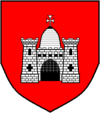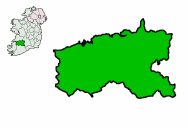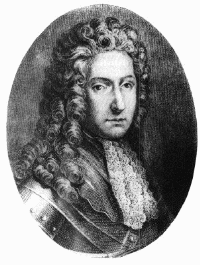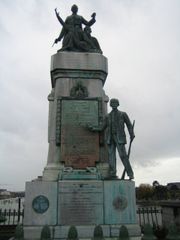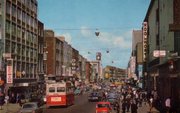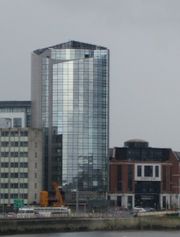History of Limerick
2007 Schools Wikipedia Selection. Related subjects: General history
The history of Limerick ( Irish: Luimneach), the fourth largest city in the Republic of Ireland and one of Ireland's major cultural and industrial centres, stretches back to its establishment by the Vikings as a walled city on "King's Island" (an island in the River Shannon) in 812, and its charter in 1197. A great castle was built on the orders of King John in 1200. It was besieged three times in the 17th century, resulting in the famous Treaty of Limerick and the flight of the defeated Catholic leaders abroad. Much of the city was built during the following Georgian prosperity, which ended abruptly with the Act of Union in 1800. The depression was to last nearly two centuries, through famine, war, and emergency, until the boom times of the 1990s. The city now boasts a rich and growing multicultural population.
Viking origins
The earliest provable settlement dates from 812; however, history suggests the presence of earlier settlements in the area surrounding King's Island, the island at the historical city centre. Antiquity's map-maker, Ptolemy, produced in 150 the earliest map of Ireland, showing a place called "Regia" at the same site as King's Island. History also records an important battle involving Cormac Mac Airt in 221 and a visit by St. Patrick in 434 to baptise an Eoghanacht Chief, Carthann the Fair. [Spellissy 98] The name Luimneach dates from at least 561, and probably derives from Loimeanach, meaning a bare marsh.
The Viking sea king, Thormodr Helgason, built the first permanent Viking stronghold on King's Island (Inis Sibhtonn) in 922. He used the base to raid the length of the River Shannon from the lake of Lough Derg to the lake of Lough Ree, pillaging ecclesiastical settlements. In 937 the Limerick Vikings clashed with those of Dublin on the lake of Lough Ree and were defeated. In 943 they were defeated again when the chief of the local Dalcassian clan joined with Ceallachan, king of Munster, and the Limerick Vikings were forced to pay tribute to the clans. The power of these Norsemen never recovered, and they reduced to the level of a minor clan; however, they often played pivotal parts in the endless power struggles of the next few centuries.
The arrival of the Normans to the area in 1173 changed everything. Domhnall Mór Ó Briain burned the City to the ground in 1174 in a bid to keep it from the hands of the new invaders. The Normans finally captured the area in 1195, under King John. In 1197, local legend claims Limerick was given its first charter and its first Mayor, Adam Sarvant. A castle, built on the orders of King John and bearing his name, was completed around 1200.
Under the general peace imposed by Norman rule, Limerick prospered as a port and trading centre. By this time the city was divided into an area which became known as "English Town" on King's Island, while another settlement, named "Irish Town", had grown on the south bank of the river. A 1574 document prepared for the Spanish ambassador attests to its wealth:
Limerick is stronger and more beautiful than all the other cities of Ireland, well walled with stout walls of hewn marble...there is no entrance except by stone bridges, one of the two of which has 14 arches, and the other 8 ... for the most part the houses are of square stone of black marble and built in the form of towers and fortresses.
Siege and treaty
Limerick was besieged several times in the 17th century. The first was in 1642, when the Irish Confederates took the King John's Castle from its English garrison. The city was besieged by Oliver Cromwell's army under Henry Ireton in 1651. The city had supported Confederate Ireland since 1642 and was garrisoned by troops from Ulster. The Confederates supported the claims of Charles II to the English throne, and the besiegers fought for a parliamentary republic. Famine and plague lead to the death of 5,000 residents before heavy bombardment of Irishtown led to breach and surrender in late October of that year.
In the Williamite war in Ireland, following the Battle of the Boyne in 1690, French and Irish forces (numbering 14,000) regrouped in behind Limerick's walls. Time and war had led to a terrible decay of the once proud fortifications. The occupying armies are recorded as claiming that the walls could be knocked down with rotten apples. The Williamite besiegers, while numbering 20,000, were hampered by the loss of their heavier guns to an attack by Patrick Sarsfield. In fierce fighting, the walls were breached on three occasions, but the defenders prevailed. Eventually the Williamites withdrew to Waterford.
William's forces returned in August 1691. Limerick was now the last stronghold of the Catholic Jacobites, under the command of Sarsfield. The promised French reinforcement failed to arrive from the sea, and following the massacre of 850 defenders on Thomond Bridge, the city sued for peace. On 3 October 1691 the famous Treaty of Limerick was signed using a large stone set in the bridge as a table. The treaty allowed the Jacobites to leave under full military honours and sail to France. Two days later French reinforcements finally arrived. Sarsfield was urged to continue the fight but refused, insisting on abiding by the terms of the treaty. Sarsfield sailed to France with 19,000 troops and formed the Irish Brigade (see also the Flight of the Wild Geese). After these forces had left the treaty was repudiated by the Williamites, a point of bitterness in the city to this day.
The famine
While the 18th century saw the gradual introduction of repressive penal laws, banning Catholics from public office, buying land or voting, Limerick's position as the main port on the western side of Ireland meant that the city, and the Protestant upper class, began to prosper. The British version of mercantilism required a great deal of trans-Atlantic trade, and Limerick profited somewhat by this. Many significant public buildings and infrastructure projects were paid for with local trade taxes. The House of Industry was built on northern bank of the river in 1774, in part as a poorhouse and infirmary. A basic sewer system was built in the Newtownpery in the time of George III by simply closing over the gutters. St. Joseph's Psychiatric Hospital was completed in the south-side by 1826. Wellesley Bridge (later, Sarsfield Bridge) and new wet docks were also built during this time. Chief imports through the port included timber, coal, iron and tar. Exports included beef, pork, wheat, oats, flour and emigrants bound for North America. Exports of food continued during the Great Famine, often requiring the deployment of troops to protect the port.
No statistics exist on how many people in the Limerick area died during the famine. Nationally, the population declined by an average of 20%, half of whom died and half emigrated. While the Great Famine reduced the population of County Limerick by 70,000, the population of the City actually rose slightly, as people fled to the workhouses.
The "Limerick Pogrom"
Having fled from persecution in Lithuania, a small number of Jewish tradespeople began arriving in Limerick in 1878. They initially formed an accepted part of the city's retail trade, centred on Collooney St. The community established a synagogue and a cemetery in the 1880s. Easter Sunday of 1884 saw the first of what were to be a series of sporadic violent anti-Semitic attacks and protests. A Jewish woman was injured and her house damaged by an angry crowd. In 1892 two families were beaten.
In 1904 a young Catholic priest, Father John Creagh, of the Redemptorist order, delivered a fiery sermon castigating Jews for their rejection of Christ, being usurers and allies of the Freemasons then persecuting the Church in France, taking over the local economy, selling shoddy goods at inflated prices, to be paid for in installments. He urged Catholics "not to deal with the Jews." The Limerick Pogrom was the economic boycott waged against the small Jewish community for over two years. Limerick's Protestant community, many of whom were also traders, supported the Jews throughout the pogrom, but ultimately Limerick's Jews fled the city.
Many went to Cork, intending to embark on ship from Cobh to travel to America. The people of Cork welcomed them into their homes. Church halls were opened for the refugees, many of whom remained. Gerald Goldberg, a son of this migration, became Lord Mayor of Cork in 1977.
Struggle for independence
The IRA and the independence movement of Sinn Féin gained popular support in Limerick following the repressions and executions of 1916. Royal Irish Constabulary carried out violent raids on the homes of suspected Sinn Féin sympathisers. Prisoners were interned without trial in Frongoch camp in North Wales. Following the arrest and death of Robert Byrne, a local republican and trade unionist, most of Limerick city and a part of the county were declared a "Special Military Area under the Defence of the Realm Act". Special permits, to be issued by the RIC, would now be required to enter the city. In response, the Limerick Trades and Labour Council called for a general strike and boycott of the troops. A special strike committee was set up to print their own money and control food prices. The Irish Times referred to this committee as a Limerick Soviet ; however, the high degree of involvement of the Catholic Church shows that it was in fact quite different from the recent Bolshevik uprising. An American army officer arriving in Limerick had to appear before the permits committee in order to get a lift to visit relatives outside Limerick, following which he said,
- I guess it is some puzzle to know who rules these parts. You have to get a military permit to get in and be brought before a committee to get a permit to leave.
After 14 days the strike ended with a compromise on the permits issue.
Open conflict erupted on Roches Street in April 1920 between the Royal Welch Fusiliers and the general population, involving bayonets on the one side and stones and bottles on the other. The troops fired indiscriminately, killing a publican and an usherette from the Coliseum Cinema. The British Government organised a new force to quell the population. The Black and Tans, known as "the sweepings of English jails", were formed of ex-servicemen. On the night of March 6, 1921, Limerick's Mayor, George Clancy, and his wife were shot in their home by three Tans. On the same night the previous Mayor, Michael O'Callaghan, was shot in similar circumstances. These assassinations became known as the Curfew Murders. IRA reprisals included the unsuccessful attack on six RIC men leaving a pub on Mungret Street and the murder of a Black and Tan on Church Street. A truce between the IRA and the British forces came into effect on July 9, 1921.
The Free State
On December 5, 1921 Eamon de Valera gave a speech (in what is now Jury's Hotel on the Ennis Road) cautioning against optimism in the peace process. A few hours later in London, Michael Collins signed the Anglo-Irish Treaty, granting limited independence to the southern portion of Ireland as the Irish Free State, while retaining Ulster. The treaty also gifted the ports of Berehaven, Cobh and Lough Swilly to the United Kingdom as UK sovereign bases, while annuities would continue to be paid to the British government in lieu of money loaned to Irish tenants under various land acts. De Valera and others virulently opposed the treaty's compromises. The scene was set for the civil war.
In Limerick, the first signs of trouble came when the British forces withdrew early in the New Year. Three separate Irish factions rushed in to fill the vacuum: The pro-Treaty Claremen of the First-Western Division under General Michael Brennan, who was asked by the new Free-State government to occupy the city because of doubts about the loyalty of Liam Forde's Mid-Limerick Brigade. In the event the Brigade split into pro- and anti-Treaty factions, the latter lead by Forde. William St. became a battle zone by 7 p.m. on 11 July 1921, when the Free Staters opened fire on the Republican garrison holding the Ordnance Barracks. In the chaos, Roches Stores, which still stands on Sarsfield St, was looted. On 17 July, Eoin O'Duffy arrived in the city as part of a nationwide offensive, in command of 1,500 Free State re-inforcements equipped with artillery. The Free Staters brought up an 18-pounder gun on the 19th and flattened the Ordnance Barracks. The Castle Barracks was captured the following day. The Republicans then abandoned the city. Limerick Prison, designed to hold 120, contained 800 prisoners by November. The Civil War ended the following May in victory for the Free State. De Valera and the Republicans would refuse take their seats in the new Dáil Éireann until 1927.
The Free State government set about rebuilding the county in the spirit of the times, with grand plans and schemes. The Shannon Scheme, the plan to build a Hydroelectric power station utilising the energy of Ireland's largest river, was begun in 1925. The German electric company Siemens-Schuckertwerke (today Siemens AG) was awarded the 5.2m pound contract, providing employment for 750 people. The Electricity Supply Board set up to manage the project gradually oversaw the electrification of rural Ireland.
The Emergency
Almost from the moment that de Valera and his new Fianna Fáil party were elected in 1932, Ireland was plunged into a series of "emergencies". De Valera fulfilled an election promise to suspend the payment of land annuities to Britain, and Britain retaliated by raising import duties on agricultural products to 40%. De Valera swept through the Dáil the "Emergency Imposition of Duties order" imposing reciprocal taxes. Economic War had begun.
Limerick's farm-based economy was reduced to a state of barter. This was the period during which Ireland's interventionist, control economic style was developed. The Laissez-faireism of the 1920s was abandoned in the face of skyrocketing unemployment, poverty and emigration. The state set up non-agricultural industries such as Turf Development Board (Later Bord na Móna) and Aer Rianta (airports authority). In 1935 Charles Lindbergh was consulted on the building of an airport on the Shannon Estuary at Rineanna (later renamed Shannon Airport), and in 1937 Foynes was developed as a stopping point on the flying boat route across the Atlantic. During this time, the de Valera government introduced several emergency laws to suppress the IRA and General Eoin O'Duffy's fascist Blueshirt army.
This first Emergency ended in 1938 with the Anglo-Irish Free Trade Agreement, when Neville Chamberlain's appeasement policy allowed a climb down. The UK would end economic sanctions and return the treaty ports in exchange for a once-off payment of £10m.
The following year, the outbreak of World War II forced the introduction of the Emergency Powers Act to control prices and imports. Ireland, with no native merchant fleet, and no coal, gas, or oil supplies faced hard times indeed. An army officer named Captain McKenna described it as the day "Realisation dawned on Ireland that the country was surrounded by water, and that the sea was of vital importance to her." Towards the end of the war, shortages of rubber and petrol particularly ended all non-emergency motorised transport, including rail, to and within the city. Lord Adare restarted a four-horse stagecoach route to his hotel in Co. Limerick, a sight not seen since the 19th century.
The army was expanded massively to over 300,000 in preparation for the expected invasion by either Germany, attempting a stepping-stone approach to the invasion of Britain, or Britain herself, seeking use of the ports. Knockalisheen barracks (later Knockalisheen Refugee Camp) was built near Limerick at Meelick to house the new defence forces.
Post war
The economy of the Limerick area was largely neglected in the post war period and the city and county became characterised by extremely high emigration and unemployment. With the exception of Shannon Airport and a few related businesses and a few clothing factories, Limerick had no industry. The economy was based on farming and services, fueled in no insignificant part by remittances from the extensive diaspora. A few of the many who left became successful abroad, including the actor Richard Harris the BBC presenter Terry Wogan, and the school teacher turned memoirist, Frank McCourt.
Limerick also had a few famous visitors during this time. In 1963 Irish-American US President John F. Kennedy visited Limerick as part of his tour of Ireland. He was presented with a locally produced christening robe made of Limerick Lace. From 1956, about 500 Hungarian refugees were housed in Knockalisheen, near Meelick a few kilometers from the city, following the failed uprising in their country. A few settled, but the majority moved on within a few years to new lives in the UK and North America due to the bad economic situation in Limerick.
Shannon airport also attracted a varied crowd. At this time nearly all transatlantic flights stopped at the airport, the most westerly in Europe, to refuel. Irish Times journalist Arthur Quinlan who was based at Shannon boasts at having interviewed every US president from Harry Truman to George H. W. Bush and many Soviet leaders, including Andrey Vyshinsky and Andrei Gromyko. He also famously taught Fidel Castro how to make an Irish coffee and is the only western journalist to have interviewed Che Guevara. On March 13th, 1965, Guevara suddenly arrived at the airport when his flight from Prague to Cuba developed mechanical problems, and Quinlan was on hand to interview him. Guevara talked of his Irish connections through the name Lynch and of his grandmother's Irish roots in Galway. Later, Che, and some of his Cuban comrades, went to Limerick city and adjourned to the Hanratty's Hotel on Glentworth Street. According to Quinlan, they returned that evening all wearing sprigs of shamrock, for Shannon and Limerick were preparing for the St. Patrick's Day celebrations. ( Scotsman Newspaper, The night Che Guevara came to Limerick, Sun 28 Dec 2003)
In 1968, the government published the Buchanan Report on the regional dimension to economic planning which had largely been ignored. The report recommended on the social and economic sustainability of industry in the regions, which gradually lead to investment and improvement in the Limerick area.
Celtic Tiger
The seemingly sudden economic growth of the 1990s, termed the Celtic Tiger, making Ireland one of the richest countries in the world, had deep foundations stretching back through the 1980s and 1970s. Shipping in Shannon estuary was developed extensively during the period with over 2bn pounds investment. A tanker terminal at Foynes and an oil jetty at Shannon Airport were built. In 1982 a massive Alumina Extraction Plant was built at Aughinish. 60,000-ton cargo vessels now carry raw bauxite from West African mines to the plant, where it is refined to alumina. This is then exported to Canada where it is further refined to aluminium. 1985 saw the opening of a huge power plant at Moneypoint, fed by regular visits by 150,000-tonne tankers. EEC funding was poured into infrastructure. Industrial estates at Raheen and Plassey ( Castletroy), and energetic government intervention, brought in numerous foreign firms, notably Analog Devices, Wang Laboratories and Dell Computers. A science and engineering focused third-level college called NIHE, Limerick, elevated since 1992 to university status as the University of Limerick, and the establishment of Limerick Institute of Technology, furthered the area's reputation as Ireland's Silicon Valley. Thomond College of Education, Limerick was a successful teacher training college and was integrated into the university in 1991.
In 1996 the city had a brief moment of world attention when the Irish writer Frank McCourt published Angela's Ashes. The book tells of the author's childhood in a rundown and dirty slum of the 1930s and 40s. The book won the Pulitzer prize and was made into a feature film in 1999. The slums spoken of in the book had long since been removed, and local people were embarrassed by the sudden unflattering discussion of the city. When McCourt wrote the book's sequel, 'Tis, it was answered with the locally written Tisn't, which painted a better face on the city.
The appearance of the city has been undergoing a gradual face-lift: two new bridges over the Shannon, and soon a tunnel to complete the orbital road; many of the older buildings have been replaced, some controversially such as the ancient Cruises Hotel (see Architecture of Limerick). City architect, Jim Brown, led the way in turning Limerick around to face the river. Ireland's third tallest building, the 58m Riverpoint, completed in 2006, near Steamboat Quay, an area of fashionable restaurants overlooking the Shannon. The new wealth not only halted the high levels of emigration chronic through the 1980s, but led to the first large-scale immigration for centuries. The City now boasts a Russian delicatessen, a Chinese supermarket and several South Asian, African and Caribbean food shops. Near the Crescent Shopping Centre, and down the road from the Mormon church, is Limerick's first Mosque.
